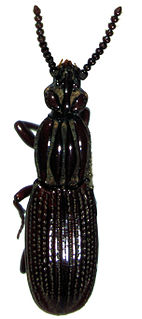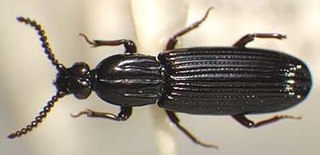
Ground beetles are a large, cosmopolitan family of beetles, Carabidae, with more than 40,000 species worldwide, around 2,000 of which are found in North America and 2,700 in Europe. It is one of the ten most speciose animal families, as of 2015.

Rhysodidae is a family of beetles, consisting of more than 350 species in about 20 genera.
Walther Hermann Richard Horn was a German entomologist who specialised in beetles (Coleoptera). He was born in Berlin, where he also died. He is not to be confused with the American entomologist George Henry Horn, another entomologist that studied Coleoptera.

Calosoma is a genus of large ground beetles that occur primarily throughout the Northern Hemisphere, and are referred to as caterpillar hunters or searchers. Many of the 167 species are largely or entirely black, but some have bright metallic coloration. They produce a foul-smelling spray from glands near the tip of the abdomen. They are recognizable due to their large thorax, which is almost the size of their abdomen and much wider than their head.
Anophthalmus is a genus of ground beetle endemic to Europe. It contains the following species:

Carabinae is a subfamily of beetles in the family Carabidae, containing the following genera:

Nebriinae is a subfamily of beetles in the family Carabidae, containing the following genera:

Orthogoniinae is a subfamily of ground beetles. Occasionally it was treated as a tribe Orthogoniini of subfamily Harpalinae, particularly when this was circumscribed loosely.
Psydrinae is a subfamily of beetles in the family Carabidae.
Rhysodinae is a subfamily of wrinkled bark beetles in the family Carabidae. The group of genera making up Rhysodinae has been treated as the family Rhysodidae in the past, and DNA analysis has more recently supported treating it as the tribe Rhysodini.
Grouvellina is a genus of beetles in the family Carabidae, containing the following species:

Dhysores is a genus of beetles in the family Carabidae, containing the following species:

Omoglymmius is a genus of wrinkled bark beetles in the family Carabidae, found on every continent except Africa and Antarctica. There are at least 150 species in Omoglymmius.
Plesioglymmius is a genus of wrinkled bark beetles in the family Carabidae. Specimens of this genus are rare.

Kaveinga is a genus of wrinkled bark beetles in the family Carabidae, containing the following species:

Trechinae is a subfamily in the ground beetle family, Carabidae.

Elaphropus is a genus of ground beetles in the family Carabidae. There are at least 370 described species in Elaphropus.
Luzonotrechus is a genus of beetles in the family Carabidae, containing the following species:

Rhysodini is a tribe of wrinkled bark beetles in the family Carabidae. There are about 19 genera and at least 380 described species in Rhysodini.
Carl Hildebrand Lindroth was a Swedish entomologist and a professor at Lund University. He was a specialist in carabidology, with a special interest in biogeography. He was a strong proponent of the glacial refugium hypothesis and made use of the framework to explain the distribution patterns of Scandinavian beetles.












